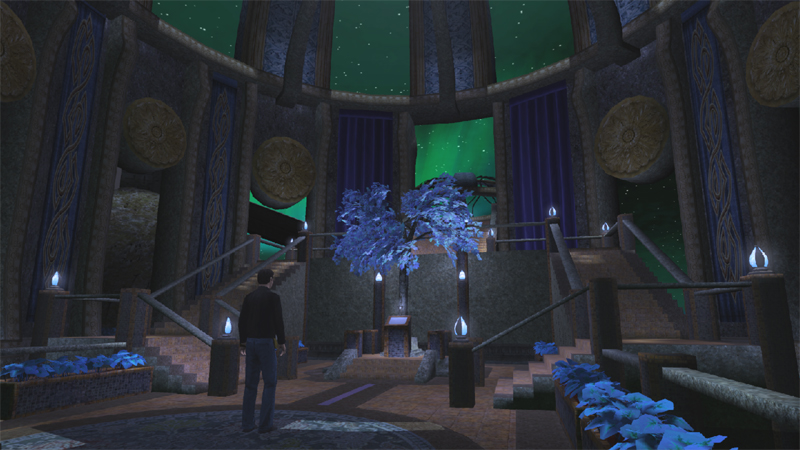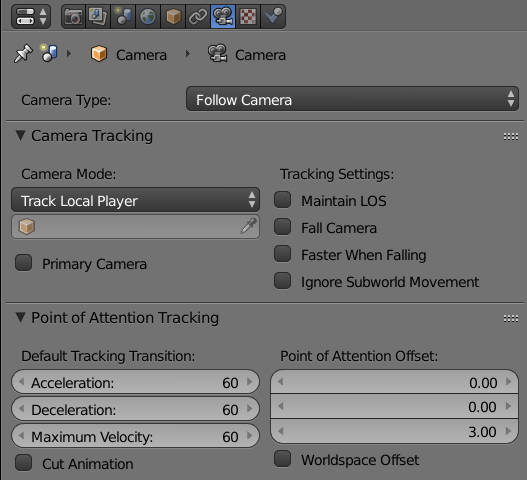Korman:Cameras
| This is a tutorial page.Versions available: PyPRP; 3ds Max; Korman. |
This tutorial will teach you how to wire cameras using the Korman plugin.
Contents
Introduction
As of version 0.07, Korman supports the export of cameras. These are especially handy if you want to have a more cinematic angle as you walk through a particular area of an Age or to just keep the default camera a bit closer behind the avatar.
This tutorial will go through all the options and types of cameras in order to better control it in-game.
What you'll need
- A camera region that activates the camera
- The camera object itself, in some cases pointed towards the scene you desire. This is optional if you're using an Auto Follow camera.
Camera Region
While this can technically be any shape you'd like, a cube mesh resized to the area you'd like to encompass works the best.
For best results, when finished resizing and shaping your region, reapply the scale by pressing Ctrl+A and selecting Scale.
Camera Modifier
In order to tell the camera to turn on, we need to set the region with the camera modifier.
In the Properties window, head over to the Physics panel, click on Add Modifier and then click Camera.
The drop down menu will give you two choices:
- Manual Camera: The default option. Use this if you're activating a camera object.
- Auto Follow Camera: For use when you'd like to adjust the camera that follows behind the avatar. See below for settings.
Camera
Depending on what you'd like the camera to do, once you add the camera object itself, you may have to move and rotate it to frame the scene you'd like in an age. If you set the camera to fix itself on the avatar or object, then you only need to worry about placement.
To see how things will look through the camera, select the camera, then either press Ctrl+Numpad0 or in the 3D View, press View->Cameras->Set Active Object as Camera
NOTE to PyPRP users: There is no need to turn the camera around 180 degrees after placement anymore. Korman compensates automatically, so face the camera exactly as you'd like it to appear in-game.
Once your camera is set the way you like, you can then click on the Data panel button (looks like an old style movie camera). This panel will give you several options to adjust.
Default Options
These are settings that can be modified for any camera.
Camera Tracking
- Camera Mode: Options are Track Local Player (follows the avatar), Track Object, or Don't track (camera stays stationary).
- Primary Camera: Click this if this will be your Age's default camera.
Tracking Settings
Check any of these that you'd like to apply to your camera:
- Maintain LOS: LOS = line of sight. Tells the camera it should track the object no matter what.
- Fall Camera: The camera will align vertically with the avatar when they fall. Example: Bahro caves.
- Faster When Falling: The camera's velocity will have a floor when the avatar is falling. Example: The Great Shaft?
- Ignore Subworld Movement: Use this if you don't want the camera tied to any subworld activity.
Point of Attention Tracking
- Default Tracking Transition: The options here...Acceleration, Deceleration, and Maximum Velocity...tell the camera how fast or slow to slide into place (assuming the transition isn't set to cut).
- Point of Attention Offset
This is the settings that can offset the camera from a tracked object's origin. For instance, if used to follow an avatar, if you entered the settings of 0, 0, 6, top to bottom, the camera focuses on the head, while 0, 0, 0 would focus on its feet. Use the settings that look best when the camera follows what it's tracking.
To be continued...




